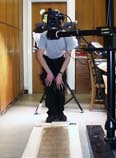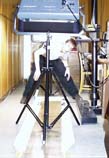Conserving and imaging LV 3804-5
The papyrus was unrolled (don't ask how) by Dr Shelagh Jameson in 1981. It turned out to be nearly complete: twenty-two joined papyrus sheets, each 13-14 cm wide. The accounts documents on both sides were published in 1988, in a volume (LV) of documentary papyri edited by John Rea.
Published papyri are routinely conserved between sheets of glass, taped at the edges, but glass was never going to work for a ten-foot monster like 3804-5. The solution turned out to be perspex, which flexes — although, unfortunately, it also scratches very easily. Revel Coles recalls that the long perspex sheets were tricky to get hold of, and cost almost £100, a lot of money at the time. Ever since publication, the perspex-encased papyrus has gathered dust on the central table in the papyrology workroom.
Even with our excellent new camera stand — vibration-free, and tall enough to serve as a gallows — a papyrus over ten feet long was always going to be tricky. Before the papyrus could even be moved, the twenty-year-old tape that held the perspex frame together had to be replaced:






